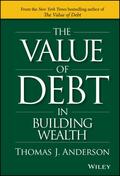The Value of Debt in Building Wealth
Creating Your Glide Path to a Healthy Financial L.I.F.E.

1. Auflage April 2017
272 Seiten, Hardcover
Wiley & Sons Ltd
Kurzbeschreibung
In The Value of Debt in Building Wealth, bestselling author Thomas J. Anderson encourages you to rethink the concept of debt. You'll learn how the wise use of debt may help secure the financial future you envision. Should you rent or buy? How important is liquidity? How much debt should you have? What type of debt should you have? What debt-to-income ratio should you aim for? This thought-provoking book will open your eyes to strategies for achieving your goals faster and with healthier finances.
* Explore strategies for smart debt management
* Gain an understanding of investment basics and key financial concepts
* Discover the best methods of saving for retirement and college
* Understand the risks of having debt and the potential risks of being debt-free
The Value of Debt in Building Wealth is full of ideas you can apply to your own situation. Read this book today, and thank yourself later.
The book of financial wisdom that your future self will thank you for reading
For many adults under 40, 'debt' is a four-letter word--something that should be avoided but is all too often unavoidable. In The Value of Debt in Building Wealth, bestselling author Thomas J. Anderson encourages you to rethink that. You'll walk away from this book with an understanding of how you can use debt wisely to secure the financial future you envision for yourself and your family. Student loans, mortgages, lines of credit, and other forms of debt are all discussed in detail, with a focus on smart planning for those who are accumulating assets--and debt--now.
Should you rent or buy? How important is liquidity? What is good versus bad debt? How much debt should you have? What debt-to-income and debt-to-asset ratios should you aim for? Fixed debt or floating debt? What's the best way of saving for college and retirement? These are big questions that deserve thorough answers because the choices you make now could influence the course of your life. This thought-provoking book will open your eyes to savvy financial strategies for achieving your goals faster and with healthier bank accounts.
* Explore strategies for smart debt management, explained by one of the nation's top financial advisors
* Gain an understanding of investment basics and key financial concepts you'll need to achieve your long-term goals
* Understand the risks of having debt and the potential risks of being debt-free
* Make financial decisions now that will maximize your wealth, freedom, and opportunity later
This book is not about buying things you cannot afford. It is about liquidity, flexibility and optimizing your personal balance sheet. The Value of Debt in Building Wealth is full of ideas you can apply to your own situation--no matter what your current asset level. Read this book today and thank yourself later.
Acknowledgments xv
About the Author xix
Introduction xxiii
Chapter 1: The Traditional Glide Path 1
In a Perfect World, No Debt! But Our World Isn't Perfect 2
You Owe a Debt to Your Future Self 3
Break the Paycheck-to-Paycheck Cycle 4
Companies Embrace Balance 5
The Power of Savings 6
A New Glide Path: Debt Adds Value 8
Finding Your Glide Path 11
The Need for Specific, Actionable Advice 12
Endnotes 14
Chapter 2: Foundational Facts 17
All Debt Is Not Equal: Oppressive, Working, and Enriching Debt 18
Paying Down Debt Gives You a Return Equal to Your After-Tax Cost of That Debt 20
Sh*t Happens--Value Liquidity 20
Yes, You Can--Save 24
Compounding Matters--For the Upside and the Downside 26
The Past Is the Past; Focus on the Future 29
Behavioral Economics Matters 30
Endnotes 31
Chapter 3: A Balanced Path to L.I.F.E. 33
Phase 1: Launch! 37
Phase 2: Independence 51
Endnotes 62
Chapter 4: Freedom and Equilibrium 65
Phase 3: Freedom 66
Phase 4: Equilibrium 76
Bonus Phase: No Debt! 80
Endnotes 82
Chapter 5: The Other Side of the Balance Sheet 85
The Probability of an 8 Percent Rate of Return Is Zero 86
Risk, Return, and Diversification 87
What about Interest Rates and Cost of Debt? 95
What about One of Your Biggest Assets? Your House 97
Three Buckets of Money 99
Risk Matters--The Risk of Time 105
Factoring Leverage into Returns 107
Debt as an Integrated Part of Your Investment Philosophy 109
Endnotes 110
Chapter 6: Proof of the Value of Debt 113
The Big Picture--Debt Can Be Valuable 115
Children and College Savings 127
Interest Rates and Debt Service CoverageRatios 128
Endnotes 128
Chapter 7: Conclusion 131
Taking a Stand Against Conventional Wisdom 132
Endnotes 137
Appendix A: Phi Phound Me 139
Inspiration Arrived 140
Not Perfect Makes Perfect 142
Applying the Fibonacci Sequence 142
From 13 to 8 148
From 8 to 5 150
Super Cool Math 151
Endnotes 154
Appendix B: Understanding the Power of Securities-Based Lending 155
Case Study 156
The Power of Securities-Based Lending 159
First Bank of Mom and Dad 162
Endnotes 163
Appendix C: Home Purchase and Financing Considerations 165
Don't Rush to Buy a House 166
When Home Ownership Can Go Wrong 168
Save Yourself the Anguish 169
Be Careful! 170
All Mortgages Are Not Created Equal 171
Owning Can Be Great 175
Endnotes 176
Appendix D: The Millennial's Guide to Debt and Getting Started 179
Saddled by Student Loans 180
The Best Budget: Spend Less Than You Make 182
Debt-to-Income Ratios 185
Pulling These Concepts Together 188
Endnotes 188
Appendix E: The Math Behind the Examples 191
Chapter 1: The Nadas, Steadys, and Radicals 193
Chapters 3 and 4: Brandon and Teresa 199
Higher Income 210
Endnotes 216
Glossary 219
Resource Guide 225
Bibliography 231
Suggested Reading 233
Index 235


